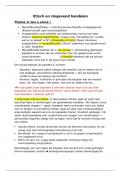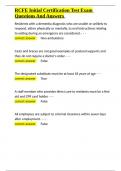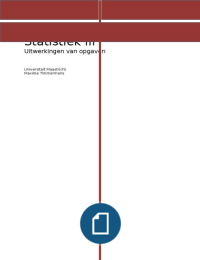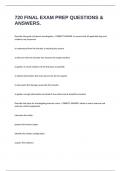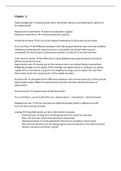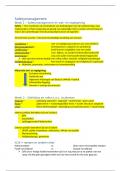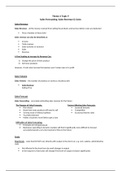SUMMARY
Advanced MRI
Goethals Jozefien
0
,Table of Contents
Flow imaging ............................................................................................................ 5
Flow effects on MR images .................................................................................. 5
TOF effects: flow out of plane ....................................................................... 5
TOF effects: flow within the plane ................................................................. 7
Phase effects ......................................................................................................... 8
Time of flight MR angiography ............................................................................ 9
TOF MR angiography: static material suppression .................................... 10
TOF MR angiography: flow sensitisation ..................................................... 10
Contrast enhanced angiography .................................................................... 11
Principles of 3D gadolinium enhanced MR angiography ........................ 11
Patient set-up and positioning .................................................................... 11
Selection of optimal imaging parameters ................................................. 12
Timing of the gadolinium bolus ................................................................... 13
Quantitative flow MR imaging .......................................................................... 14
Introduction ................................................................................................... 14
Phase contrast images ................................................................................. 15
Sequence ...................................................................................................... 15
Phase contrast angiography and velocimetry.......................................... 17
diffusion ................................................................................................................... 18
Diffusion as a probe for microstructure ............................................................ 18
Diffusion: physical principles .............................................................................. 18
Random walk ................................................................................................ 19
Restricted and free diffusion .............................................................................. 20
Diffusion and diffusion weighting in MRI ........................................................... 21
ADC maps ..................................................................................................... 22
Biomedical applications .................................................................................... 23
Characterization of brain oedema ............................................................ 23
DTI: diffusion tensor imaging .............................................................................. 24
Eigenvalues ................................................................................................... 25
Fiber tracking................................................................................................. 26
Diffusion kurtosis tensor imaging (DKI) .............................................................. 27
contrast agents and memri................................................................................... 28
1
, Intrinsic contrast .................................................................................................. 28
General use ......................................................................................................... 28
Contrast mechanisms......................................................................................... 28
Spin density.................................................................................................... 29
Diffusion and perfusion ................................................................................. 29
Magnetization transfer ................................................................................. 29
T1 relaxation time or spin lattice relaxation................................................ 30
T2 relaxation time or spin spin relaxation .................................................... 30
Susceptibility .................................................................................................. 31
Requirements CA ................................................................................................ 32
Administration ..................................................................................................... 32
Contrast agents .................................................................................................. 32
Paramagnetic contrast agents ................................................................... 33
Superparamagnetic contrast agents ......................................................... 34
Positive contrast agents ............................................................................... 35
Negative contrast agents ............................................................................ 35
Biodistribution ................................................................................................ 35
Applications ........................................................................................................ 36
MEMRI: Manganese enhanced MRI ........................................................... 36
USPIO .............................................................................................................. 37
perfusion bolus tracking......................................................................................... 38
Definition .............................................................................................................. 38
MRI perfusion without contrast agent ........................................................ 38
MRI perfusion with contrast agent .............................................................. 38
Contrast agents .................................................................................................. 39
Positive versus negative contrast agent..................................................... 39
Principle methods using blood pool tracers .................................................... 39
Principle ......................................................................................................... 39
Quantification ............................................................................................... 40
Perfusion MRI technique .................................................................................... 43
Principle bolus tracking MRI ......................................................................... 43
MRI acquisition .................................................................................................... 46
Spin echo versus gradient echo ................................................................. 46
2
, FLASH versus EPI............................................................................................. 47
Applications ........................................................................................................ 48
arterial spin labelling (asl) ...................................................................................... 49
Introduction ......................................................................................................... 49
Principle ASL-NMR ......................................................................................... 49
Contineous labelling........................................................................................... 50
Two approaches ........................................................................................... 50
Continuously labeling ................................................................................... 51
Magnetization transfer contrast .................................................................. 52
One coil ......................................................................................................... 53
ASL with saturation of macromolecules ..................................................... 55
ASL without saturation of macromolecules ............................................... 56
Test ASL method............................................................................................ 56
Echo planar imaging .................................................................................... 57
One coil versus two coil system ................................................................... 57
Experimental results ............................................................................................ 57
Problems ........................................................................................................ 58
Effect anesthesia .......................................................................................... 58
From CASL to pCASL .......................................................................................... 59
Pulsed labeling .................................................................................................... 60
FAIR................................................................................................................. 60
T1 method...................................................................................................... 61
Parameters .......................................................................................................... 62
Labeling efficiency ....................................................................................... 62
Absolute CBF calculation ............................................................................ 62
Subtraction methods .................................................................................... 62
fmri ........................................................................................................................... 63
Functional imaging methods ............................................................................ 63
Physiological effects ........................................................................................... 64
Neuronal activity........................................................................................... 64
Neurometabolic- neurovascular coupling ................................................ 65
BOLD time course ......................................................................................... 65
Physical effects ................................................................................................... 66
3



